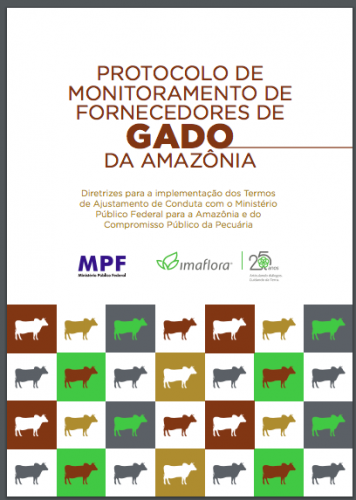Understanding the Monitoring Protocol

The Monitoring Protocol is the benchmark whereby slaughterhouses and beef processing companies of the Amazon region can meet their social and environmental commitments either through the Terms of Adjustment of Conduct (TACs) with the Public Prosecutor’s Office, the Public Livestock Commitment or through private policies undertaken publicly. This protocol, created by several hands, became official on July 1, 2020.
According to the project coordinator of Imaflora's Climate and Agricultural Chains Initiative, Lisandro Inakake de Souza, the main innovation of this document is the harmonization and clarity of the technical rules that detail TAC criteria. As such, the meatpackers are able to monitor their cattle suppliers and fully meet their commitments.
Before the Monitoring Protocol, different approaches were used to monitor livestock suppliers. Each company interpreted the criteria differently. It was, therefore, impossible to measure or compare the performance of the meatpackers.
The TAC criteria are the same for everyone and are in accordance with the documents signed by the companies and the Public Prosecutor’s Office. The interpretation of the criteria and the applicable way to monitor and meet this criterion is what has been standardized to ensure ongoing improvements in the oversight of animal purchases by meatpackers.
Good practice
The Monitoring protocol was developed with basis on the TAC benchmarks but it can be adopted by any company. All meatpackers that purchase cattle, whether they are signatories of TACs with the public prosecutor’s office or not, can monitor their suppliers. Voluntary adherence to this protocol demonstrates a meatpacker's commitment to good practices and makes their actions more transparent to society.
Monitoring Protocol Timeline
| 2009 | 2010 | 2013 | 2016 | 2020 |
| Large meatpackers take on a commitment to monitor their purchases of cattle sourced from the Amazon | Several companies sign the Legal Meat TAC | The Brazilian supermarket association (ABRAS) and the largest retail chains make a public commitment to eliminate deforestation from their supply chains | Major supermarket chains agree to monitor their direct suppliers (meatpackers) and to develop control tools | The Harmonised Monitoring Protocol is launched |
Welcome to our blog!
The Beef on Track Project is a joint effort to strengthen the social and environmental commitments of the beef value chain in the Amazon and drive its implementation.
VOLUNTARY MONITORING PROTOCOL FOR CATTLE SUPPLIERS IN THE CERRADO – Draft 1 for consultation – July, 2021
The protocol is a partnership between Proforest and Imaflora, which has the objective of facilitating the implementation of best practices for monitoring direct cattle suppliers in the biome
INFO BRIEF Nº. 2 - MONITORING CATTLE SUPPLIERS: THE NECESSARY HARMONIZATION
The document shows the importance of clear and precise rules to guide the monitoring of cattle suppliers in the Amazon.




